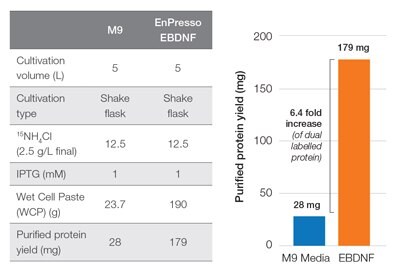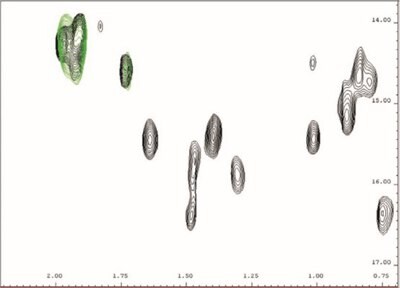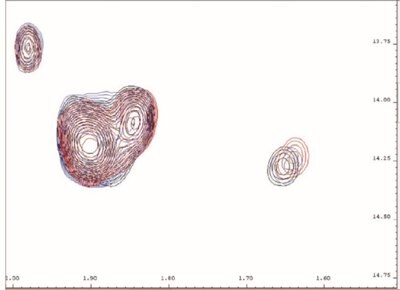Production of Dual-labelled Proteins
Dr. Alan Robertson, Dr. Ben Davis
Vernalis, UK Ltd.
Introduction
One challenge in NMR is the need to produce higher yields of functionally labelled recombinant protein, and then isotopically label these for rapid spectral analysis in structural studies.
Traditionally a chemically defined growth medium such as M9 has a limited availability in nutrient rich protein sources; resulting in slower cell growth, a lower final biomass and subsequently less labelled protein available.
EnPresso® B Defined Nitrogen-free is a chemically defined, pre-sterilised growth medium with the key elements to support growth, control pH and regulate glucose availability resulting in:
- Controlled growth with higher growth rate
- Higher biomass
- Significantly higher levels of labelled protein available for analysis by NMR spectroscopy.
Dr. Alan Robertson and Dr. Ben Davis at Vernalis, Ltd., UK, a provider of drug discovery and development services, have refined a novel protocol for the duallabelling of proteins using EnPresso® B Defined Nitrogen-free.
Their protocol is based on an endogenous amino acid suppression method and shows a 6-fold increase in 15N, methionine-(methyl-13C) dual-labelled protein when compared with M9 medium.
Method
EnPresso® B Defined Nitrogen-free (EBDNF) is a chemically defined, pre-sterilised growth medium with the key elements to support cell growth, and when used in conjunction with exogenously supplied 15NH4CL to label proteins with the 15N isotope of nitrogen achieves significantly higher yields of labelled recombinant protein than with M9 medium.
Robertson and Davis developed a process for methionine labelling by inhibiting the methionine synthesis with the addition of amino acids prior to induction. This labelling method was adapted and modified from Van Duyne et al (1993) and now been incorporated with the EnPresso® B Defined Nitrogen-free protocol.
Robertson and Davis achieved a 6.4 fold increase in dual labelled protein than with M9 media, and have selectively labelled methionine residues with the addition of amino acid prior to induction.
An overview can be found in Table 1.
Case Study Vernalis Ltd., UK
15N – L-Methionine-(methyl-13C) labelling. Comparison of M9 with EBDNF together with some experimental figures and conditions have been provided.

Table 1.Yields using traditional M9 medium in comparison to EBDNF.
No significant scrambling of the 13C label can be ovserved with the EnPresso® system.

Figure 1.Selective labelling with L-Methionine-(methyl-13C). A region of the 13C-1H HSQC NMR spectrum of a 28 kDa protein is shown. Uniformly 13C labelled protein is shown in black, while the same protein labelled selectively with L-Methionine-(methyl-13C) is shown in green. No significant scrambling of the 13C label is observed following protein expression with EBDNF
Ligand binding shows specificity with the selective binding.

Figure 2.Ligand binding identified by Met chemical shift perturbations. A region of the 13C-1H HSQC NMR spectrum of a 47 kDa protein is shown. The protein was labelled selectively with L-Methionine(methyl-13C). Apo protein (100 μM) is shown in black, with a low affinity fragment then added to 500 μM (blue) and 1 mM (red). Binding is observed to selectively perturb a single Met residue, highlighted in the red circle. This residue had been previously mapped to the active site using a literature ligand.
Conclusion
- An effective protocol has been developed to produce 15N-13C-met dual labelled proteins for NMR spectroscopy using the EnPresso® B Defined Nitrogen free system.
- The protocol utilises feedback inhibition of methionine synthesis with the addition of amino acids prior to induction.
- Adapted and modified from van Duyne et al (1993) and integrated with EnPresso® B Defined nitrogen free achieves a 6.4 fold increase in dual labelled protein over M9 media.
Benefits of EnPresso® B Defined Nitrogen free
- A controlled growth system providing higher yields of isotopically-labelled protein when compared with M9.
- Sterile tablet format (add to sterile water) minimising risk of inclusion bodies due to autoclave effects.
- Consistency in glucose source, pH control and temperature present a rich media for optimal growth conditions of E. coli resulting in higher Biomass and yield of protein.
Reference(s)
To continue reading please sign in or create an account.
Don't Have An Account?